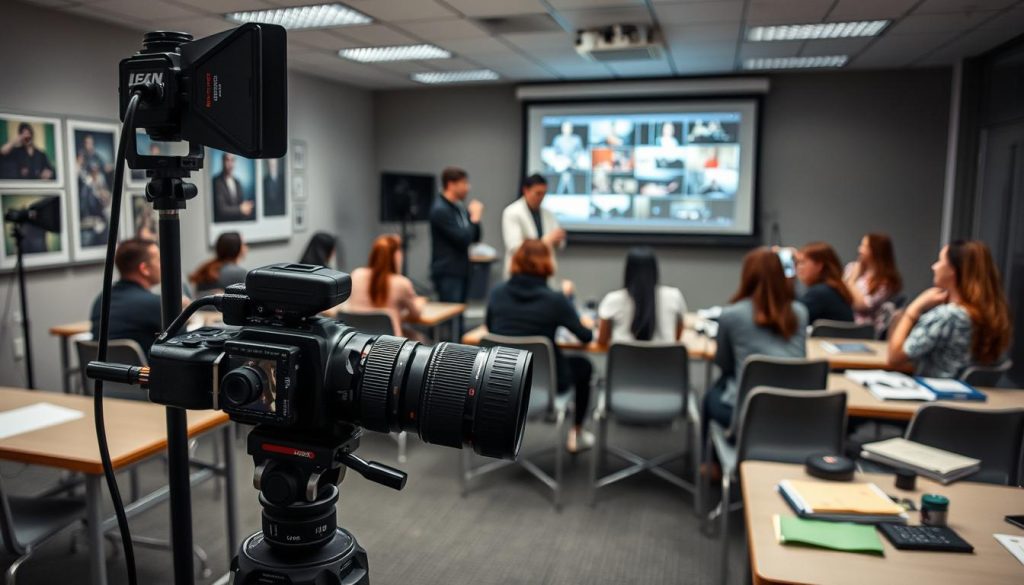For many, photography is more than just a profession; it’s a way of life. As a photographer, you’re not just capturing moments; you’re turning your vision into a business. The path of a freelance photographer offers the freedom to create, but it also demands a high level of adaptability and entrepreneurial spirit.
The landscape of photography as a business is rapidly evolving, presenting both opportunities and challenges. To navigate this dynamic environment and achieve growth, it’s crucial to balance artistic vision with business acumen.
Table of Contents
Key Takeaways
- Understand the evolving landscape of photography as a business.
- Learn to balance artistic vision with entrepreneurial skills.
- Discover strategies for achieving financial stability.
- Explore approaches to establishing a unique market position.
- Gain insights into building a sustainable career.
The Reality of Freelance Photography Today
The world of freelance photography is complex, requiring a blend of artistic talent and business acumen. A successful freelance photographer must be adept at not only capturing compelling images but also managing the business side of their profession.
What Makes Freelance Photography Unique
Freelance photography stands out due to its demand for a dual skill set: the ability to create high-quality, engaging photographs and the capacity to run a profitable business. This unique blend of artistic and entrepreneurial skills sets freelance photographers apart.
The Dual Role: Artist and Entrepreneur
A photographer must juggle the creative aspects of their work with the responsibilities of being an entrepreneur, including tasks such as negotiating contracts, managing finances, and finding new clients. Effective time management is crucial to balancing these diverse responsibilities and ensuring the longevity of their career. Successful photographers understand that dedicating time to both the artistic and business aspects of their profession is essential.
Essential Technical Skills for Success
Technical skills are the backbone of a successful freelance photography career. To deliver high-quality images that meet client expectations, photographers must be proficient in both camera equipment and post-production techniques.
Mastering Camera Equipment and Techniques
Understanding your camera equipment is fundamental. This includes knowledge of aperture, shutter speed, and ISO to capture the perfect photo. Familiarity with different lenses and lighting setups can significantly enhance the quality of your photos.
Post-Production and Editing Proficiency
In today’s digital age, post-production is as crucial as the shooting process. Proficiency in industry-standard software like Adobe Lightroom and Photoshop is non-negotiable. Developing a consistent editing style helps establish your visual signature and strengthens your brand identity.
| Skill | Importance | Software/Equipment |
|---|---|---|
| Camera Handling | High | DSLR/Mirrorless Cameras |
| Editing | High | Adobe Lightroom, Photoshop |
| Color Theory | Medium | Color Grading Tools |
By mastering these skills and staying updated with the latest technology, freelance photographers can produce compelling images that resonate with clients.
Building Your Photography Specialization
The path to becoming a renowned freelance photographer involves refining one’s photographic approach. In an age where digital tools are accessible to all, what sets a good freelance photographer apart is less about technique and more about their perspective. This perspective, shaped by experience, visual culture, and sensitivity, becomes a true signature.
Popular Photography Niches in France
France, with its rich cultural heritage and diverse landscapes, offers numerous opportunities for photographers to specialize in various niches. Some of the most popular niches include wedding photography, fashion photography, and landscape photography. Understanding the demand for different types of photography services in France can help you identify where your interests and skills align.
How to Discover Your Unique Style
Discovering your unique photographic style involves a combination of deliberate experimentation and organic evolution through consistent practice. Studying the work of established photographers while avoiding direct imitation can help you understand what elements resonate with your creative vision. Client feedback also provides valuable insights into your natural strengths, helping you refine your photography approach toward a recognizable signature style.
| Photography Niche | Description | Key Skills Required |
|---|---|---|
| Wedding Photography | Capturing the essence of wedding ceremonies and events | Attention to detail, ability to work under pressure |
| Fashion Photography | Showcasing clothing and models in a visually appealing manner | Understanding of lighting, composition, and styling |
| Landscape Photography | Capturing the beauty of natural landscapes | Patience, knowledge of natural light, and composition |
Creating a Professional Portfolio That Converts
A well-crafted portfolio is the cornerstone of a successful freelance photography career, serving as a visual resume that showcases your expertise. To attract potential clients, your portfolio must be both visually stunning and strategically presented online.
Curating Your Best Work
When curating your portfolio, focus on showcasing your most impactful and relevant work. This involves selecting images that not only demonstrate your technical skill but also tell a story or evoke an emotional response. Your goal is to create a narrative that resonates with potential clients and sets you apart from the competition.
Online Portfolio Platforms and Personal Websites
To maximize your visibility, consider publishing your portfolio on dedicated website platforms like Behance or Format, which offer additional exposure and specialized tools. However, having a personal website provides complete control over presentation and creates a more professional impression than social media profiles alone. Ensure your online presence is optimized for both desktop and mobile viewing, with fast loading times and intuitive navigation.
For more insights on developing your freelance career, explore our resources on exploring freelance projects.
Legal Frameworks for Freelance Photography in France

Navigating the legal landscape is a critical aspect of a successful freelance photography career in France. As a photographer, you must be aware of the various legal considerations that impact your business and protect your rights regarding your photos.
Micro-Entrepreneur vs. Other Business Structures
Choosing the right business structure is essential. The micro-entrepreneur status is popular among freelancers due to its simplicity, but other structures like individual limited liability companies may offer better protection and benefits for your business.
Understanding Photography-Specific Regulations
Freelance photographers must comply with specific regulations, including copyright law (droit d’auteur), image rights (droit à l’image), and tax regulations. Understanding these laws is crucial for managing your clients and business effectively.
| Regulation | Description | Impact on Photographers |
|---|---|---|
| Copyright Law (Droit d’Auteur) | Automatically protects photographic works | Essential for licensing terms and client agreements |
| Image Rights (Droit à l’Image) | Requires explicit permission from recognizable subjects | Critical for commercial usage and avoiding legal issues |
| Tax Regulations | Includes specific deductions for equipment and expenses | Impacts financial planning and tax returns |
Setting Your Rates and Managing Finances
Establishing a successful freelance photography career requires not only artistic talent but also sound financial management. As a freelancer, you face the challenge of managing your finances during busy and slow periods.
Pricing Strategies That Reflect Your Value
Your pricing strategy should reflect the value you bring to your clients. To achieve this, consider your costs, expertise, and the market rate for your services. Setting the right price is crucial for maintaining a profitable business. It’s essential to regularly review and adjust your pricing to ensure it remains competitive and aligned with your growing expertise and business expenses.
Financial Planning for Irregular Income
Managing finances as a freelancer can be challenging due to irregular income. To mitigate this, consider creating a financial buffer to cover 3-6 months of expenses. This safety net provides stability during slow periods. Additionally, implement systematic accounting practices to track your business health, and plan for taxes by setting aside savings quarterly. Diversifying your income streams can also help smooth out revenue fluctuations.
Finding and Securing Reliable Clients
The key to a thriving freelance photography business lies in establishing strong, lasting relationships with clients. As a freelance photographer, understanding how to listen to client requests, provide artistic and technical guidance, and adapt to unexpected situations is crucial. This not only ensures client satisfaction but also fosters a loyal client base that can provide a stable income stream.
Effective Networking Strategies
Effective networking is vital for expanding your client base. This involves attending industry events, joining professional photography associations, and leveraging social media platforms to connect with potential clients. By building a strong network, you can increase your visibility and opportunities for new projects. For more insights on developing your clientele, you can visit this resource.
Building Long-Term Client Relationships
Building long-term relationships with clients is key to a sustainable freelance photography business. This involves delivering high-quality work, maintaining regular communication, and understanding each client’s business objectives to propose relevant photography solutions. By doing so, you can ensure that clients return to you for future projects, providing a stable source of income.
- Long-term client relationships provide more stable income and reduce the constant pressure of finding new business opportunities.
- Exceeding expectations on initial projects lays the foundation for ongoing client relationships.
- Regular, proactive communication between projects keeps you top-of-mind when clients have new photography needs.
To illustrate the importance of client relationships, consider the following table that highlights the benefits of long-term client engagement:
| Benefits | Short-Term Clients | Long-Term Clients |
|---|---|---|
| Income Stability | Unpredictable | Stable |
| Referrals | Limited | Frequent |
| Project Opportunities | Few | Multiple |
« The goal is to turn your clients into raving fans who can’t wait to work with you again. »
Marketing Your Freelance Photography Business
As a freelance photographer, marketing your services is just as important as capturing stunning images. To attract new clients and grow your business, you need a solid marketing strategy.
Social Media Strategies for Photographers
Utilizing social media effectively is crucial for photographers to showcase their work and engage with potential clients. Platforms like Instagram and Facebook allow you to share your portfolio, behind-the-scenes content, and interact with your audience. By maintaining a consistent online presence, you can build your brand and attract new business opportunities.
To maximize your social media impact, use relevant hashtags, post regularly, and engage with your followers by responding to comments and messages promptly.
Local SEO and Online Visibility
Local SEO optimization is vital for freelance photographers to reach clients in their area. By creating a complete Google Business Profile with accurate location information, business hours, and regularly updated photos, you can improve your visibility in local search results.
Additionally, incorporating location-specific content on your website and blog helps search engines understand your service area, making it more likely for local clients to find you. Online reviews and testimonials also play a significant role in building credibility and enhancing your local search rankings.
Managing Client Projects from Start to Finish
Delivering exceptional results and managing client expectations are essential skills for freelance photographers aiming to build a loyal client base. Effective project management involves several key elements that ensure client satisfaction and foster a positive experience.
Clear Communication and Setting Expectations
Clear communication is vital from the outset of any project. This includes discussing the project’s scope, timelines, and deliverables with the client to set realistic expectations. Quality checks are also integral to this process, ensuring that the final product meets the client’s needs.
Delivering Results That Exceed Expectations
To deliver results that exceed client expectations, consider the following practices:
- Implement quality control processes to ensure technical excellence in every delivered image.
- Present final deliverables thoughtfully, whether through curated online galleries or elegant physical packaging, to enhance the client experience.
- Ensure timely delivery and maintain clear communication if any delays occur.
- Follow up personally after project completion to demonstrate attention to detail and commitment to client satisfaction.
Diversifying Your Income Streams

To achieve a sustainable career, freelance photographers must consider diversifying their income streams. Relying solely on client work can be precarious due to the unpredictable nature of freelance photography.
Beyond Client Work: Stock Photography and Prints
Exploring stock photography and selling prints can provide additional revenue streams. Stock photography allows photographers to license their images for commercial use, generating passive income. Selling prints, on the other hand, enables photographers to monetize their work directly, offering customers a tangible product. Institutions like Spéos offer various training courses that can enhance a photographer’s skills in these areas.
Teaching and Workshop Opportunities
Freelance photographers can also diversify their income by teaching and conducting workshops. By sharing their expertise, photographers can create a more predictable income stream. Opportunities include developing photography workshops, creating online courses, and offering one-on-one mentoring programs. According to experts, « Creating online courses offers scalable income potential, with the initial investment of time yielding ongoing returns as students enroll. »
Continuous Growth Through Learning and Adaptation
The key to sustained success in freelance photography lies in embracing a culture of continuous learning and adaptation. As the industry evolves, staying updated with the latest trends, technologies, and best practices is crucial for maintaining a competitive edge.
Staying Current with Industry Trends
To remain relevant, it’s essential to stay informed about the latest industry trends. This involves investing in training that focuses on advanced techniques and equipment upgrades that address specific technical limitations. Specialized training in areas relevant to your niche can create competitive advantages, justifying premium pricing.
Investing in Advanced Training and Equipment
Strategic equipment upgrades and course enrollments should be guided by your business growth objectives and the need to enhance your skills. Creating a professional development budget ensures consistent growth investment, regardless of short-term income fluctuations. For more insights on growing your freelance business, visit this resource.
Overcoming Common Challenges in Freelance Photography
As a freelance photographer, navigating the challenges of the profession is crucial for long-term success. Freelance photography is a rewarding career, but it comes with its unique set of obstacles that can impact a photographer’s stability and creative fulfillment.
Managing Seasonal Fluctuations
Seasonal fluctuations can significantly affect a freelance photographer’s workload. To manage these fluctuations effectively, it’s essential to:
- Plan Ahead: Anticipate slow periods and plan your finances accordingly.
- Diversify Services: Offer a range of services to attract clients throughout the year.
- Market Strategically: Adjust your marketing strategies to target clients who are active during your slow periods.
Preventing Creative Burnout
Creative burnout is a common challenge many freelance photographers face. To prevent it, consider the following strategies:
- Establishing clear boundaries between work and personal time prevents the constant availability that often leads to burnout.
- Engaging in personal projects can reignite your creative passion by allowing exploration without client constraints.
- Connecting with fellow photographers provides both emotional support and practical problem-solving during challenging periods.
- Maintaining physical well-being directly impacts your creative energy, making regular exercise and sufficient rest essential.
- Mindful scheduling that includes recovery time between intensive projects helps maintain consistent creative quality.
Conclusion: Building a Sustainable Career in Freelance Photography
Building a sustainable career in freelance photography means embracing both the creative and commercial aspects of the profession. It’s about balancing image-making skills with strategic business practices. To achieve long-term growth and establish a strong brand, a photographer must develop their unique style while aligning with their target market.
By diversifying revenue streams, adapting to industry changes, and giving equal attention to both creative and business aspects, freelance photographers can ensure ongoing relevance and success.
FAQ
What are the key elements to include in a professional portfolio for a photographer?
A professional portfolio should showcase your best work, demonstrating your style and versatility. It should be curated to attract your target clients, whether they’re looking for event, wedding, or portrait photography services. Make sure it’s easily accessible online through platforms or your personal website.
How do I determine my rates as a photographer?
Determining your rates involves considering your experience, the level of expertise you bring to a project, and the costs associated with your business, such as equipment and marketing expenses. Research what other photographers in your niche are charging to ensure your rates are competitive.
What business structure is most suitable for a photographer?
The most suitable business structure depends on your specific circumstances, including your income level, business expenses, and personal preferences. For many, the micro-entrepreneur status is an attractive option due to its simplicity and flexibility.
How can I effectively market my photography services?
Effective marketing involves leveraging social media platforms to showcase your work, engaging in local SEO to improve your online visibility, and networking with potential clients and other professionals in the industry.
What are some strategies for managing irregular income as a photographer?
Managing irregular income requires careful financial planning, including budgeting for slow periods and saving a portion of your earnings during busier times. Diversifying your income streams, such as through stock photography or teaching, can also help stabilize your finances.
How can I prevent creative burnout?
Preventing creative burnout involves maintaining a healthy work-life balance, taking breaks when needed, and continually challenging yourself with new projects or techniques. Staying inspired by the work of other artists and photographers can also help keep your creative juices flowing.





